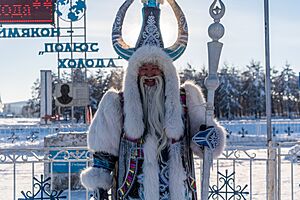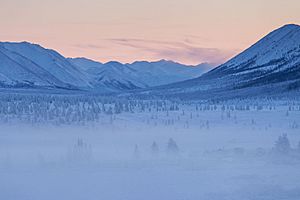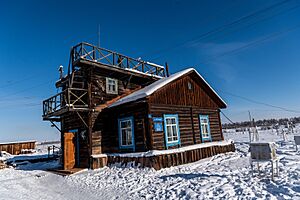Oymyakon facts for kids
Quick facts for kids Oymyakon (English)Оймякон (Russian) Өймөкөөн (Yakut) |
|
|---|---|
| - Rural locality - Selo |
|
 |
|
| Administrative status | |
| Country | Russia |
| Federal subject | Sakha Republic |
| Administrative district | Oymyakonsky District |
| Municipal status | |
| Municipal district | Oymyakonsky Municipal District |
| Statistics | |
| Population (2010 Census, preliminary) |
462 inhabitants |
| Population (February 5, 2018 est.) | 500–900 inhabitants |
| Time zone | MAGT (UTC+12:00) |
| Postal code(s) | 678752 |
| Dialing code(s) | +7 41154 |
Oymyakon is a small village in the Sakha Republic of Russia. It is located in the Yana-Oymyakon Highlands, next to the Indigirka River. This village is famous for being the coldest permanently inhabited place on Earth. Imagine living somewhere where winter temperatures are usually below freezing!
Contents
What's in a Name?
Oymyakon gets its name from the Oymyakon River. One idea is that the name comes from an Even language word, kheium. This word means "unfrozen patch of water" or "a place where fish spend the winter." Another idea suggests the Even word heyum, which means "frozen lake," is the source.
Geography and Climate
Oymyakon is surrounded by two main valleys. These valleys act like a bowl, trapping cold air in the village. This makes the climate extremely cold for most of the year.
It often snows in spring and autumn. However, it rarely snows in summer or winter. This is because of something called the Siberian High in winter. This high-pressure system brings clear, very cold, and dry air.
Temperatures can get so cold that schools close if it's colder than -55 degrees Celsius. Even in summer, temperatures can be above 0 degrees Celsius.
A Glimpse into History
During World War II, an airfield was built near Oymyakon. This airfield was part of the Alaska-Siberian (ALSIB) air route. It was used to fly American planes to help the Soviet Union in the war.
Oymyakon is also close to the historic Road of Bones. This road was built a long time ago in very harsh conditions.
Over the past few decades, the number of people living in Oymyakon has gone down. The village once had about 2,500 people. By 2018, this number was less than 900. The main ways people make a living here are through fur trading and ice fishing.
Beliefs and Traditions

Most people in Oymyakon are either Orthodox Christians or do not follow a religion. Some people also follow traditional beliefs like Aiyy Faith and Shamanism. These beliefs often involve respecting nature and spirits.
The Pole of Cold
Oymyakon is known as one of the Northern Pole of Cold locations. The other is the town of Verkhoyansk, which is about 629 km away by air. The weather station in Oymyakon is in a valley. This valley is surrounded by mountains that are higher up. The mountains trap cold air, making the valley even colder.
The ground in Oymyakon is always frozen. This is called continuous permafrost.
Record-Breaking Cold
There is a monument in Oymyakon that marks an unofficial temperature reading from January 1924. It was -71.2 degrees Celsius! On February 6, 1933, the weather station officially recorded -67.7 degrees Celsius. This was one of the coldest official temperatures ever recorded in the Northern Hemisphere. Only Antarctica and Greenland have recorded lower temperatures. The lowest ever was -89.2 degrees Celsius in Antarctica.
In some years, temperatures drop below 0 degrees Celsius in late September. They stay below freezing until mid-April. Oymyakon has never recorded a temperature above freezing between October 26 and March 16. In the coldest month on record, January 1931, the average temperature was -54.1 degrees Celsius.
Summer in Oymyakon
Even though winters are very long and cold, summers in Oymyakon can be mild or even warm. Sometimes, summer nights are cool. In June, July, and August, temperatures above 30 degrees Celsius are not rare during the day. On July 7, 2022, the warmest night ever was recorded, with a low of 18.6 degrees Celsius.
On July 28, 2010, Oymyakon recorded its highest temperature ever: 34.6 degrees Celsius. This means the difference between the coldest and warmest temperatures ever recorded is a huge 105.8 degrees Celsius!
Plant Life
The climate in Oymyakon is quite dry. However, because it's so cold for most of the year, not much water evaporates from the ground until summer. Summers are much wetter than winters. Despite the harsh winters, some trees, like the Dahurian larch, can still grow here.
| Climate data for Oymyakon (1991–2020, extremes 1891–present) | |||||||||||||
|---|---|---|---|---|---|---|---|---|---|---|---|---|---|
| Month | Jan | Feb | Mar | Apr | May | Jun | Jul | Aug | Sep | Oct | Nov | Dec | Year |
| Record high °C (°F) | −16.6 (2.1) |
−12.5 (9.5) |
3.8 (38.8) |
11.7 (53.1) |
26.2 (79.2) |
31.7 (89.1) |
34.6 (94.3) |
32.9 (91.2) |
23.7 (74.7) |
11.0 (51.8) |
−2.1 (28.2) |
−6.0 (21.2) |
34.6 (94.3) |
| Mean daily maximum °C (°F) | −42.1 (−43.8) |
−35.8 (−32.4) |
−19.8 (−3.6) |
−3.0 (26.6) |
9.7 (49.5) |
20.0 (68.0) |
23.0 (73.4) |
18.5 (65.3) |
9.1 (48.4) |
−8.3 (17.1) |
−30.2 (−22.4) |
−41.9 (−43.4) |
−8.4 (16.9) |
| Daily mean °C (°F) | −45.7 (−50.3) |
−42.2 (−44.0) |
−30.2 (−22.4) |
−12.7 (9.1) |
3.5 (38.3) |
12.7 (54.9) |
15.3 (59.5) |
10.8 (51.4) |
2.5 (36.5) |
−13.8 (7.2) |
−34.4 (−29.9) |
−45.0 (−49.0) |
−14.9 (5.2) |
| Mean daily minimum °C (°F) | −49.3 (−56.7) |
−47.6 (−53.7) |
−39.2 (−38.6) |
−22.9 (−9.2) |
−3.5 (25.7) |
4.4 (39.9) |
6.9 (44.4) |
3.2 (37.8) |
−3.3 (26.1) |
−19.2 (−2.6) |
−38.8 (−37.8) |
−48.3 (−54.9) |
−21.5 (−6.7) |
| Record low °C (°F) | −65.4 (−85.7) |
−67.7 (−89.9) |
−60.6 (−77.1) |
−46.4 (−51.5) |
−28.9 (−20.0) |
−9.7 (14.5) |
−9.3 (15.3) |
−13.2 (8.2) |
−25.3 (−13.5) |
−47.6 (−53.7) |
−58.5 (−73.3) |
−62.8 (−81.0) |
−67.7 (−89.9) |
| Average precipitation mm (inches) | 6 (0.2) |
7 (0.3) |
5 (0.2) |
5 (0.2) |
15 (0.6) |
39 (1.5) |
46 (1.8) |
38 (1.5) |
24 (0.9) |
13 (0.5) |
13 (0.5) |
7 (0.3) |
218 (8.6) |
| Average extreme snow depth cm (inches) | 24 (9.4) |
28 (11) |
30 (12) |
24 (9.4) |
3 (1.2) |
0 (0) |
0 (0) |
0 (0) |
0 (0) |
6 (2.4) |
15 (5.9) |
20 (7.9) |
30 (12) |
| Average rainy days | 0 | 0 | 0.03 | 0.4 | 10 | 17 | 17 | 18 | 13 | 1 | 0 | 0 | 76 |
| Average snowy days | 23 | 23 | 16 | 10 | 9 | 1 | 0.2 | 0.3 | 9 | 21 | 23 | 20 | 156 |
| Average relative humidity (%) | 75 | 74 | 72 | 68 | 60 | 59 | 65 | 70 | 73 | 79 | 77 | 74 | 71 |
| Mean monthly sunshine hours | 28 | 118 | 244 | 284 | 282 | 304 | 298 | 236 | 151 | 113 | 58 | 13 | 2,129 |
| Source 1: Погода и Климат, World Meteorological Organization (February record low) | |||||||||||||
| Source 2: NOAA (sunshine hours 1961–1990) | |||||||||||||
Images for kids
See Also
 In Spanish: Oimiakón para niños
In Spanish: Oimiakón para niños
- Summit Camp
- Oymyakon Plateau




